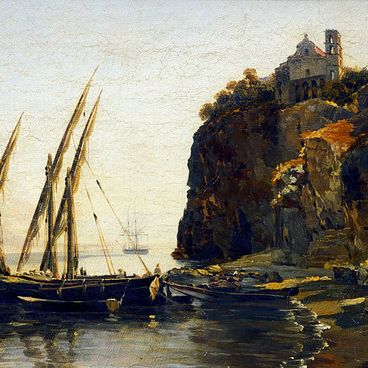In his youth, the Belgian painter Gustave Leonard de Jonghe showed remarkable talent for playing violin. However, being even more attracted to painting, the young de Jonghe chose to devote himself to this art. His first teacher was his father, landscape painter Jean Baptiste Jonghe. Then he continued his education with the famous artist Louis Gallet. He moved to Paris in the mid-1850s, worked there for about thirty years, then returned to Belgium in 1884. He was strongly influenced by Alfred Stevens, who was a famous master of genre scenes.
Although Gustave Jonghe was Belgian by birth, many consider him to be a French artist, like Stevens. Gustave Jonghe started with portraits and historical compositions. However, he gained fame thanks to genre scenes, mainly from the life of fashionable society. He was most successful in portraying young women and children. The artist’s works are very rhythmic, probably due to his musical education. The painting from Radishchev Museum is a typical example of his work. A bird was traditionally considered a symbol of female chastity. The lady’s attitude suggests that she is lovesick at the eve of meeting with her beloved. Rather than a painting, this work is a study or a sketch expertly executed with a wide brush.
The pictorial texture of the work, its original color scheme, and its decorative effect situate it at the threshold of Art Nouveau style. However, the silhouette of the dress, with a tournure and a train, is characteristic of the historicism that was peculiar to the earlier period of the 1870s. At the time, the crinoline was going out of fashion, while the tournure was just entering into vogue. In the late 1870s, light-colored dresses became fashionable.
The pictorial texture of the work, its original color scheme, and its decorative effect situate it at the threshold of Art Nouveau style. However, the silhouette of the dress, with a tournure and a train, is characteristic of the historicism that was peculiar to the earlier period of the 1870s. At the time, the crinoline was going out of fashion, while the tournure was just entering into vogue. In the late 1870s, light-colored dresses became fashionable.
The composition clearly includes an element of irony, as the artist depicted the lady in mirror reflection to her parrot, showing the likeness between the bird and the fashionista. It seems that the painting was created during the Parisian period of Jonghe’s work, where, as follows from the dedicatory inscription, it was given to the founder of Radishchev Museum A.P. Bogoloubov. The artist’s name had a different pronunciation in Russian at different times, so it is featured in several transcriptions in archive documents and publications. Pre-revolutionary publications mention it as Deyong and Delong, while the 1923 Catalogue of the Radishchev Museum transcribes the name as Dejong.



